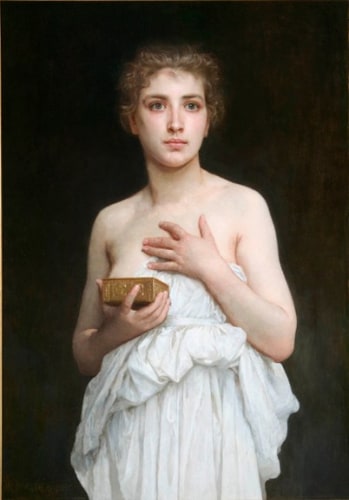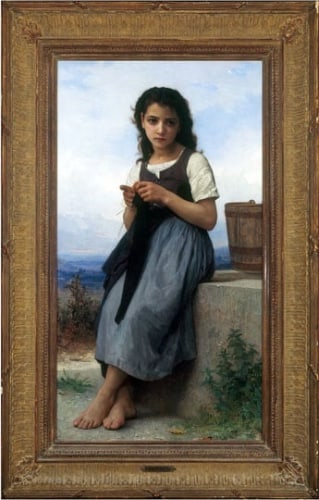William Adolphe Bouguereau, one of, if not the most important academic painters of the nineteenth-century was renowned for his mythological, allegorical, religious and historical subjects as well as his portraits and contemporary genre scenes. The artist was born at La Rochelle on November 30, 1825 and died in the same city on August 19th, 1905.
Bouguereau was the son of a wine-seller who at first wanted his son to pursue a career in commerce. However, thanks to the intervention of an uncle who was sympathetic to his nephew's artistic ambitions, the young Bouguereau was able to take his first drawing lessons at the College de Pons near Saintes. At the age of sixteen he enrolled at the École des Beaux- Arts in Bordeaux. It is said that as he began his studies, he completed thirty portraits in just a few months.
In 1846 Bouguereau went to Paris and became a pupil at the École des Beaux-Arts, working in the atelier of the Neoclassical painter François Picot (1768- 1860) who had been a student of Jacque-Louis David. In 1848 he received the second-place Prix de Rome, and the following year he made his debut at the Paris Salon with two paintings, Égalité and Portrait de Madame C.C.
Bouguereau was awarded the first-place Grand Prix de Rome in 1850 which enabled him to travel to Italy. While there he worked diligently at copying the Italian Old Masters such as Raphael, del Sarto, and Guido Reni. He also did some excellent landscape and figure studies from nature. His painting entitled The Body of St. Cecilia Borne to the Catacombs (1854), executed during his last year in Italy, established his reputation.
He returned to Paris in time to be represented at the Exposition Universelle of 1855 with his Portrait de Madame K.M.S., Tête de Bacchante and L'Amour Fraternal. He earned a second-class medal that year and a first-class medal two years later at the Salon of 1857. He had great success at the Salon with his Triomphe de Martvr, which was bought by the French government for the Musée du Luxembourg. It was about this time that he began executing important secular and religious decorations on a grand scale, a major aspect of his career. He decorated the chapels of several Parisian churches: Sainte Clotilde (1859), Saint Augustin (l866) and Saint Vincent-de-Paul (1888). He also decorated the ceiling of the Grand Theâtre in Bordeaux (1869), the Bartholony and Pereire mansions in Paris, and the cathedral and the residence of a wealthy patron in his native La Rochelle.
Bouguereau continued to be a successful and popular exhibitor at the Salon up until his death in 1905. American collectors avidly sought after his work, and there hardly was a single important American collection that did not include a Bouguereau.
Bouguereau was a highly influential teacher at the Académie Julian and the École des Beaux-Arts in Paris and, like Jean-Léon Gérôme, a major figure in the French art establishment. In his later years, with Alexandre Cabanel, he reigned supreme over the annual Salon, keeping it within the bounds of official academicism during a time when the ideals were threatened by modernism. In fact, after Meissonier formed the breakaway Société Nationale des Beaux-Arts in 1890, and the official Paris Salon became known as the “Salon Bouguereau.”
Bouguereau had one of the most brilliantly successful careers of the nineteenth-century and had every possible honor and distinction granted him. He was a member of the Institut de France (1876), president of the Société des Artistes Français, member of the jury for the Universal Expositions in Paris for 1889 and 1900, and a chevalier in the Legion of Honor (1859). He was elevated to the rank of grand officer of the Legion of Honor in 1903. Above all, Bouguereau kept alive the tradition of academic classicism right up to the beginning of the twentieth-century. His carefully structured compositions, which emphasize the idealized human figure, are worked through half tones of the highest degree of finish.


